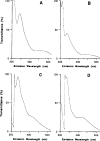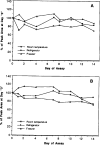Determination of harmane and harmine in human blood using reversed-phased high-performance liquid chromatography and fluorescence detection
- PMID: 10706780
- PMCID: PMC4088954
- DOI: 10.1006/abio.1999.4456
Determination of harmane and harmine in human blood using reversed-phased high-performance liquid chromatography and fluorescence detection
Abstract
A number of tremorogenic beta-carboline alkaloids have been found in common plant-derived foodstuffs, beverages, and inhaled substances. Because of their natural presence in the food chain, there is a growing concern regarding the potential risks of certain essential tremors associated with the long-term, low-level dietary exposure to these alkaloids. The purpose of this study was to develop an effective analytical method to determine blood levels of two major beta-carboline derivatives, harmane and harmine. Human blood was extracted with ethyl acetate and methyl-t-butyl ether (2:98) under an alkaline condition. After evaporation of organic solvent, the samples were reconstructed in methanol. The samples were fractionated on a 250 x 4.6-mm C18 reversed-phase column with an isocratic mobile system consisting of 17.5 mM potassium phosphate buffer (ph 6.5) and methanol (30:70), followed by an on-line fluorescence detection. The method had the detection limit to determine 206 and 81 pg/ml of harmane and harmine, respectively, in 10 ml of human blood. The intraday precision (C.V.) at 25 ng/ml was less than 6.7 and 3.4% for harmane and harmine, respectively. The interday precision was 7.3% for harmane and 5.4% for harmine. The method has proven sensitive, reproducible, and thus useful for both laboratory and clinical studies of beta-carboline toxicities.
Copyright 2000 Academic Press.
Figures



Similar articles
-
Beta-carboline alkaloids and essential tremor: exploring the environmental determinants of one of the most prevalent neurological diseases.ScientificWorldJournal. 2010 Sep 1;10:1783-94. doi: 10.1100/tsw.2010.159. ScientificWorldJournal. 2010. PMID: 20842322 Free PMC article. Review.
-
Toxicokinetics of tremorogenic natural products, harmane and harmine, in male Sprague-Dawley rats.J Toxicol Environ Health A. 2001 Dec 21;64(8):645-60. doi: 10.1080/152873901753246241. J Toxicol Environ Health A. 2001. PMID: 11766171 Free PMC article.
-
Elevation of blood beta-carboline alkaloids in essential tremor.Neurology. 2002 Dec 24;59(12):1940-4. doi: 10.1212/01.wnl.0000038385.60538.19. Neurology. 2002. PMID: 12499487 Free PMC article.
-
Determination of pharmacological levels of harmane, harmine and harmaline in mammalian brain tissue, cerebrospinal fluid and plasma by high-performance liquid chromatography with fluorimetric detection.J Chromatogr. 1989 Nov 24;496(2):269-78. doi: 10.1016/s0378-4347(00)82576-1. J Chromatogr. 1989. PMID: 2613832
-
Pharmacological and Toxicological Profile of Harmane-β-Carboline Alkaloid: Friend or Foe.Curr Drug Metab. 2017;18(9):853-857. doi: 10.2174/1389200218666170607100947. Curr Drug Metab. 2017. PMID: 28595532 Review.
Cited by
-
Blood harmane (1-methyl-9H-pyrido[3,4-b]indole) concentrations in essential tremor: repeat observation in cases and controls in New York.J Toxicol Environ Health A. 2012;75(12):673-83. doi: 10.1080/15287394.2012.688485. J Toxicol Environ Health A. 2012. PMID: 22757671 Free PMC article.
-
Metabolomic Signatures in Pediatric Crohn's Disease Patients with Mild or Quiescent Disease Treated with Partial Enteral Nutrition: A Feasibility Study.SLAS Technol. 2021 Apr;26(2):165-177. doi: 10.1177/2472630320969147. Epub 2020 Nov 18. SLAS Technol. 2021. PMID: 33207993 Free PMC article. Clinical Trial.
-
Beta-carboline alkaloids and essential tremor: exploring the environmental determinants of one of the most prevalent neurological diseases.ScientificWorldJournal. 2010 Sep 1;10:1783-94. doi: 10.1100/tsw.2010.159. ScientificWorldJournal. 2010. PMID: 20842322 Free PMC article. Review.
-
Blood Harmane (1-Methyl-9H-Pyrido[3,4-b]indole) and Mercury in Essential Tremor: A Population-Based, Environmental Epidemiology Study in the Faroe Islands.Neuroepidemiology. 2020;54(3):272-280. doi: 10.1159/000505874. Epub 2020 Jan 31. Neuroepidemiology. 2020. PMID: 32007995 Free PMC article.
-
Bioactive β-Carbolines in Food: A Review.Nutrients. 2019 Apr 11;11(4):814. doi: 10.3390/nu11040814. Nutrients. 2019. PMID: 30978920 Free PMC article. Review.
References
-
- Adachi J, Mizoi Y, Naito T, Yamamoto K, Fujiwara S, Ninomiya I. Determination of β-carbolines in foodstuffs by high performance liquid chromatography and high performance liquid chromatograph–mass spectrometry. J. Chromatogr. 1991;538:331–339. - PubMed
-
- Allen RF, Beck O, Borg S, Skroder R. Analysis of 1-methyl-1,2,3,4-tetrahydro-β-carboline in human urine and cerebrospinal fluid by gas chromatography–mass spectrometry. Eur. J. Mass Spectrom. 1980;1:171–177.
-
- Bidder TA, Shoemaker DW, Boettger HG, Evans M, Cummins JT. Harmane in human platelets. Life Sci. 1979;25:157–164. - PubMed
-
- Moncrieff J. Determination of pharmacological levels of harmane, harmine and harmaline in mammalian brain tissue, cerebrospinal fluid and plasma by high-performance liquid chromatography with fluorimetric detection. J. Chromatogr. 1989;496:269–278. - PubMed
Publication types
MeSH terms
Substances
Grants and funding
LinkOut - more resources
Full Text Sources

